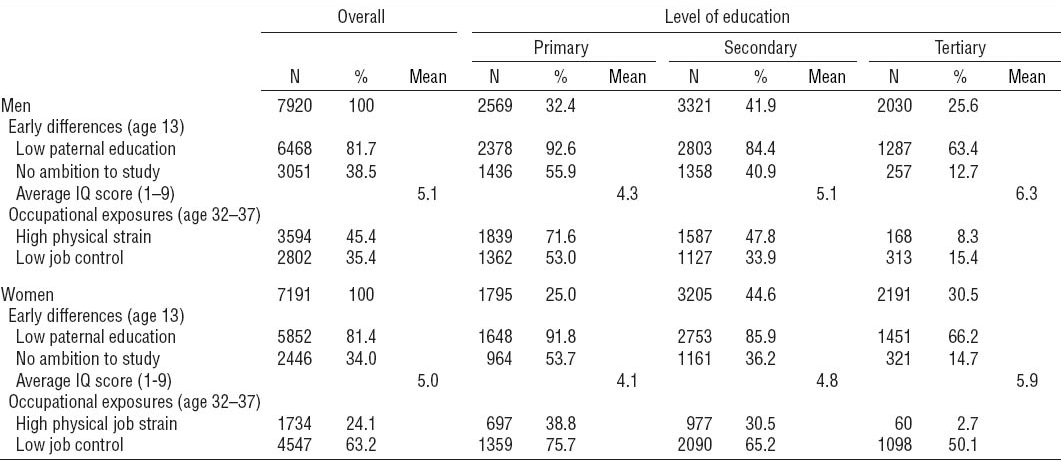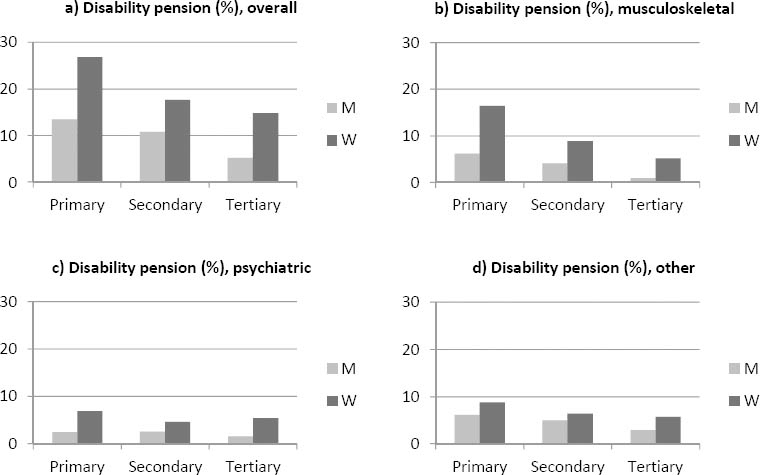Low educational attainment has been associated with earlier exit from the labor market through disability pension in a number of studies (1–6). While a majority of these studies have shown quite similar associations among men and women, a few have shown weaker associations among women (4, 6). Studies examining disability pension by type of diagnosis have suggested roughly the same association between education and disability pension for psychiatric diagnoses as for disability pension overall, but not as strong as in the case of musculoskeletal diagnoses (1, 7). A recent study from Sweden, however, demonstrated a higher probability of disability pension due to depression and anxiety among the high-educated female participants (6).
Disability pension benefits are available through the social insurance system in Sweden and most European countries, and are aimed at people with a permanent incapacity to work as a result of injury or disease (8). The proportion of people on disability pension has grown over a long period in OECD countries, even though health conditions measured by mortality or morbidity have not worsened in the same period (9).
One possible explanation for the association between lower education and risk of disability pension is higher exposure to strenuous and repetitive working conditions among low-educated persons (10, 11). This explanation has been empirically supported in several studies to a greater or lesser extent (4, 12–15). Correspondingly, both physical and psychosocial working conditions are considered to be established risk factors for disability pension (16–18). Nevertheless, it has also been suggested that lower level of education and disability pension are correlated due to common determinants (19, 20). Individual differences in abilities manifested relatively early in life, related to genetic and social background factors, have been shown to have considerable explanatory power regarding the association (21–23). A higher rate of disability pension among low-educated people, and among those in occupations with low educational requirements, is thus probably also a result of selective forces acting before entrance to the labor market (1, 24, 25). Most previous studies on education, working conditions, and disability pension have not controlled for potential confounding due to such differences between individuals (illustrated in figure 1). However, in a large cohort study (limited to males), we recently found that such differences are likely of importance (12).
Figure 1
The association between level of education (E), mediating working conditions (W), and disability pension (D) may be confounded by characteristics already present in childhood (C).
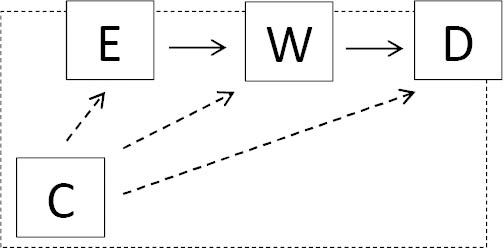
The present study aimed to examine the extent to which differences in peoples’ physical and psychosocial working conditions might explain the association between level of education and disability pension. Unlike most previous studies, the explanatory contributions from working conditions were examined with adjustment made for potentially confounding differences between individuals as measured in school. The analyses were stratified by sex to highlight possibly dissimilar associations between education and disability pensions among men and women, which has been previously suggested in the literature (4, 6). We studied associations both with overall disability pension and disability pension due to musculoskeletal and psychiatric conditions, which are the largest diagnosis groups. Education could have different associations with these (1, 7, 21).
Methods
Participants and study design
We used data from two samples of Swedish school children born in 1948 and 1953. As part of a project for longitudinal follow-up of educational achievement (“Evaluation through Follow-up”) (26), national samples of school pupils were investigated in 1961 and 1966. Both cohorts were sampled in the spring, and the sample frame was individuals born on the 5th, 15th and 25th of each month during the years 1948 (N=12 166) and 1953 (N=10 723). As in a previous study (27), the two cohorts were merged into a single file and linked to individual information from multiple administrative records on parental education, own education and occupation (in 1985, at age 32/37 years), and date and cause of disability pension or death during 1986–2008 (from age 33/37 to 55/60 years). Statistics Sweden conducted the linkages.
Education (exposure)
Data on level of education were collected from administrative school records as reported in Statistics Sweden’s register-based Labor Market Statistics (RAMS) in 1986, and was classified as primary (≤9 years); secondary (10–13 years); and tertiary (≥14 years) education in the present study.
Disability pension (outcome)
Date and cause of disability pension were obtained from the Swedish National Social Insurance Agency’s database. The Agency grants disability pension to applicants with a long-standing or permanently reduced work capacity due to medically certified illness or injury. Causes of disability pension were grouped into musculoskeletal, psychiatric, and “other” diagnoses according to the following ICD-codes: (i) musculoskeletal diagnoses: ICD-9=710-739 and ICD-10=M01-M99; (ii) psychiatric diagnoses: ICD-8 and ICD-9=290 and 292–299 (psychoses), ICD-8 and ICD–9=303 (alcohol-related diagnoses or drug use, including alcoholism), ICD-9=305 (misuse of alcohol), ICD-8 and ICD-9=291 (alcohol psychoses), ICD-9=292 (drug psychoses), ICD-8 and ICD-9=304 (drug addiction), and ICD-8=300–302/305-308 and ICD-9=300–311 (other psychiatric diagnoses), except for 303-305 in ICD-9; and (iii) other: disability pensions with the remaining ICD-codes. All first-time disability pensions were included in the study (ie, both full and partial).
Differences between individuals at age 13 (covariates)
Intellectual performance tests and questionnaires on leisure-time interests, future plans, and attitude to school were administered in school, usually in the 6th grade (in the spring, the year of most participants’ 13th birthday), and were completed by 10 437 pupils in 1961 and 9 278 in 1966. Intellectual performance tests comprise various tests (antonyms, metal folding, and number series) summarized in a score according to standardized procedures (28, 29). The intelligence score was transformed into a normalized standard 9-point scale (scores ranging from 1–9, with a mean of 5). “Ambition to study” refers to participants’ answer to the question “Will you eventually apply for secondary education/do you plan on graduating from secondary school?” in the questionnaire administered in school. Response categories were yes, no, and don’t know. Paternal education was also included in the present study: the highest level of education of the father (or other male caretaker) was reported in a questionnaire, with four pre-defined categories, primary (6 years), lower secondary (9 years), upper secondary, and tertiary. In the present study, we dichotomized the data into “primary school versus more” because of a highly skewed distribution.
Occupational exposures
Two job exposure matrices (JEM) (ie, physical strain at work and job control) were used to obtain comprehensive measurement of those physical and psychosocial working conditions that vary between occupations with high or low educational requirements. The physical strain JEM was based on questions concerning physical demands at work from the Swedish annual level-of-living surveys (1979–1981). An index has been created (30) that is defined by the sum of eight factor-analytically derived work characteristics: (i) heavy lifts daily, (ii) repetitive and one-sided work movements, (iii) awkward work postures, (iv) heavy shaking or vibrations, (v) daily perspiration from physical exertion, (vi) contact with dirt, (vii) deafening noise, and (viii)risk for exposure to accidents. Original group-specific means have been converted into population-based quartiles of physical strain at work, which we assigned to our cohorts in the present study: high, medium–high, medium–low, or low. The job control JEM was based on questions from the Swedish work environment surveys (1989–1997) concerning the defining characteristics of job control (31) – decision authority and skill discretion at work – and average scores for any of 321 job titles were ascribed to the subjects. We created four equal-sized groups also of job control: high, medium–high, medium–low, and low. Both JEM were constructed independently for men and women, ie, the same occupation could be classified differently for men and women since they are in relation to sex-specific mean exposure. The JEM were linked to the subjects’ occupational codes registered in the National Population and Housing Census 1985 (Nordic Occupation Classification, NYK, the Swedish version of ISCO-88).
Statistical analysis
The study population consisted of those 19 715 persons (9985 men and 9730 women) who performed the assessment and school surveys in the 6th grade, ie, typically at 13 years of age. Among these, we lacked information on paternal and own education for 500 and 961 individuals, respectively. Another 267 persons had been granted a disability pension before 1986 and were therefore excluded. Finally, 3157 persons for whom we lacked occupational information, needed for occupational exposure classification, were excluded. Thus, the population followed from 1986–2008 consisted of 15 111 persons (7920 men and 7191 women).
We calculated the proportion of women and men who were granted disability pension (overall and with any musculoskeletal, psychiatric, or other diagnosis) by level of education. We also calculated distributions of potential explanatory risk factors (covariates), in terms of proportions, across levels of education.
We applied Cox proportional-hazards regression to estimate associations between level of education and disability pensions, as well as associations between covariates and disability pension overall, yielding hazard ratios (HR) with 95% confidence intervals (95% CI). This is implemented in the PHREG procedure in the SAS computer program, version 9.3 (SAS Institute, Cary, NC, USA). Person-time was counted from 1 January 1986, until the date of receiving disability pension, date of death, or until the end of follow-up on 1 July 2008. Proportionality of hazards was investigated through log-log survival functions. In the regression analyses, categorical (dummy) variables were used (PHREG procedure, CLASS statement) for all factors with the exception of intellectual performance, which was adjusted for as a continuous variable in the analyses.
To test the hypothesis of working conditions as mediating factors we proceeded as follows. First, we estimated crude birth-year-adjusted associations and confounding-adjusted associations between education and disability pensions in order to show the magnitude of the potential confounding. Second, we estimated models of associations only including potentially mediating occupational exposures, given absence of interaction between education and the occupational exposures (checked by comparing associations between strata). Third, we estimated models of associations both including confounder variables and potential mediators. Fourth, we calculated the percentage attenuations of HR for primary education (with tertiary education as reference), after multivariable-adjustments, using the formula:
These calculations are used to roughly indicate the contributions from explanatory factors (32).
Results
During the 23-year follow-up, 811 men and 1372 women were granted disability pension. Among the men, 288, 167, and 356 obtained disability pension due to a musculoskeletal, psychiatric, and other disorder, respectively. Among the women, 618, 335, 419 were granted disability pension due to a musculoskeletal, psychiatric, and other disorder, respectively.
Figures 2a-d show there was an increased rate of disability pension by declining level of education among both men and women. The proportion of women granted a disability pension was considerably higher than among men for all three diagnostic groups, whereas the educational gradient in disability pensions among men were steeper than among women. Disability pension was particularly rare in the high-educated men. For both men and women, the increased rate of disability pension among those with lower education was most pronounced for disability pensions with a musculoskeletal diagnosis. Disability pensions with a psychiatric diagnosis were quite evenly distributed across educational groups.
Level of education was clearly correlated with early characteristics assessed at age 13 and working conditions measured at age 32–37 (table 1), among both men and women. The lower the level of education, the greater the proportion of men and women with low paternal education, no ambition to complete secondary education, and lower average intellectual performance. High physical strain at work differed most in proportion to educational levels. Low job control also increased in proportion to lower level of education, but it was common or very common at all levels of education among women.
Both individual and work-related characteristics were associated with disability pension (table 2). Among men, low intellectual performance and low job control showed the strongest associations. Among women, physical strain at work displayed the strongest association. However, the associations were found mainly for disability pensions with musculoskeletal diagnoses while not at all or weakly for disability pensions with psychiatric diagnoses (see Appendix, www.sjweh.fi/data_repository.php).
Table 2
Potential explanatory factors and overall disability pension (DP) among men and women [95% CI=95% confidence interval; HR=hazard ratio]
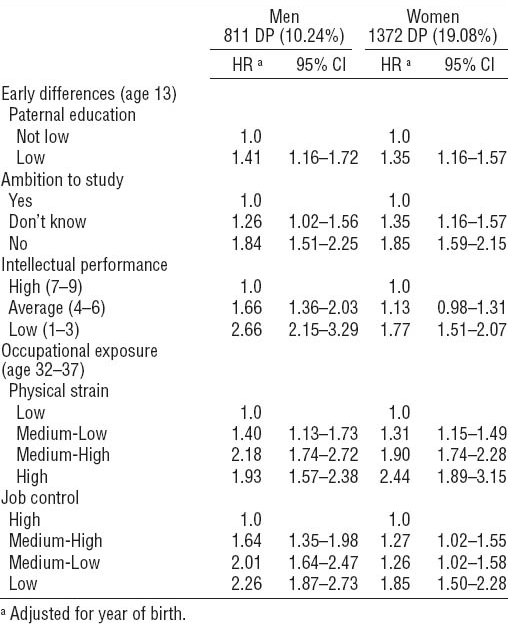
Table 3 shows that, compared with tertiary education, primary education among men was associated with an increase in the HR for overall disability pension of 2.84 (95% CI 2.28–3.53). The greatest educational difference was observed for disability pensions with a musculoskeletal diagnosis and the smallest for a psychiatric diagnosis. In multivariable analyses, a clear attenuation was shown after adjustment for early characteristics (paternal education and ambition to study and intellectual performance at age 13), except for disability pension with a psychiatric diagnosis. Adjustment for physical strain at work considerably attenuated the association with disability pensions due to musculoskeletal disorders whereas adjustment for job control attenuated all the associations with disability pensions. However, a comparison between the confounder- and fully adjusted HR (ie, HR additionally adjusted for physical strain and job control) shows that the contribution from occupational exposures was smaller after confounder adjustment. Lastly, after full adjustment, a clear association between low education and disability pension nevertheless remained.
Table 3
Multivariable-adjusted associations between level of education and disability pension (DP) among men. [95% CI=95%confidence interval; HR=hazard ratio]
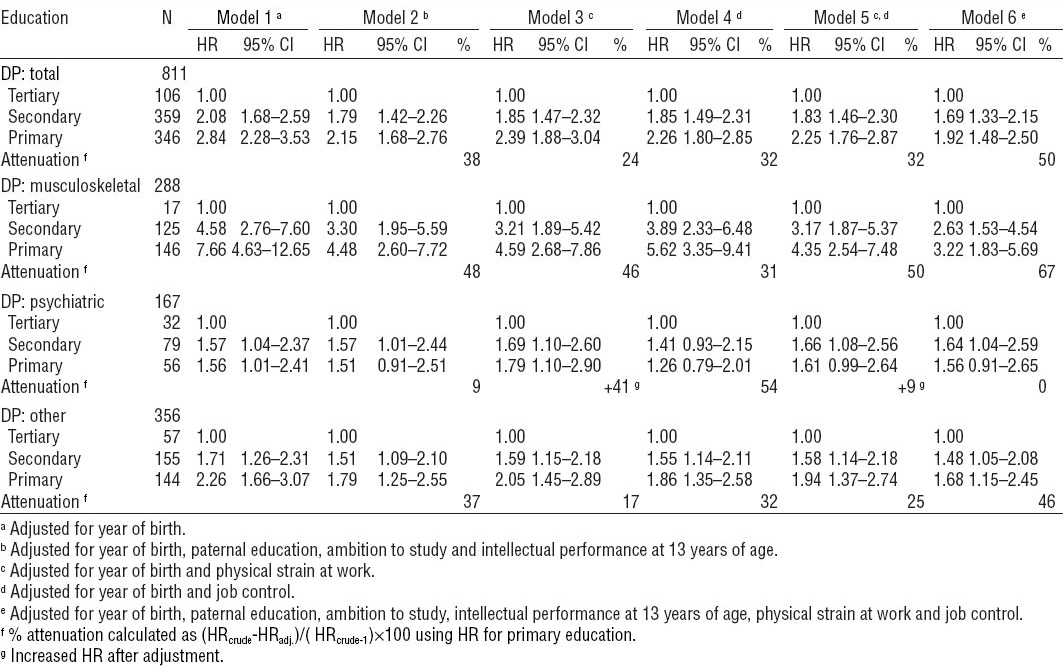
Among women (table 4), those who had primary education had an increased HR of 1.96 (95% CI 1.70–2.26) for overall disability pension, compared to those with tertiary education. An association was found especially among the women who had disability pension with musculoskeletal diagnosis, while a weak association was found among those with disability pension due to psychiatric diagnosis. After adjustment for early determinants, there were considerable attenuations of HR, again with the exception of disability pension with psychiatric diagnoses. Slightly smaller attenuations were seen after adjustment for physical strain at work and/or job control, of which the latter had a rather weak impact on associations among women. As for the men, a comparison between the confounder- and fully adjusted HR shows that the contribution from occupational exposures does not look as large after confounder adjustment. Further, after full adjustment, less of the association between education and disability pension remained among women than men.
Table 4
Multivariable-adjusted associations between level of education and disability pension (DP) among women. [95% CI=95% confidence interval; HR=hazard ratio]
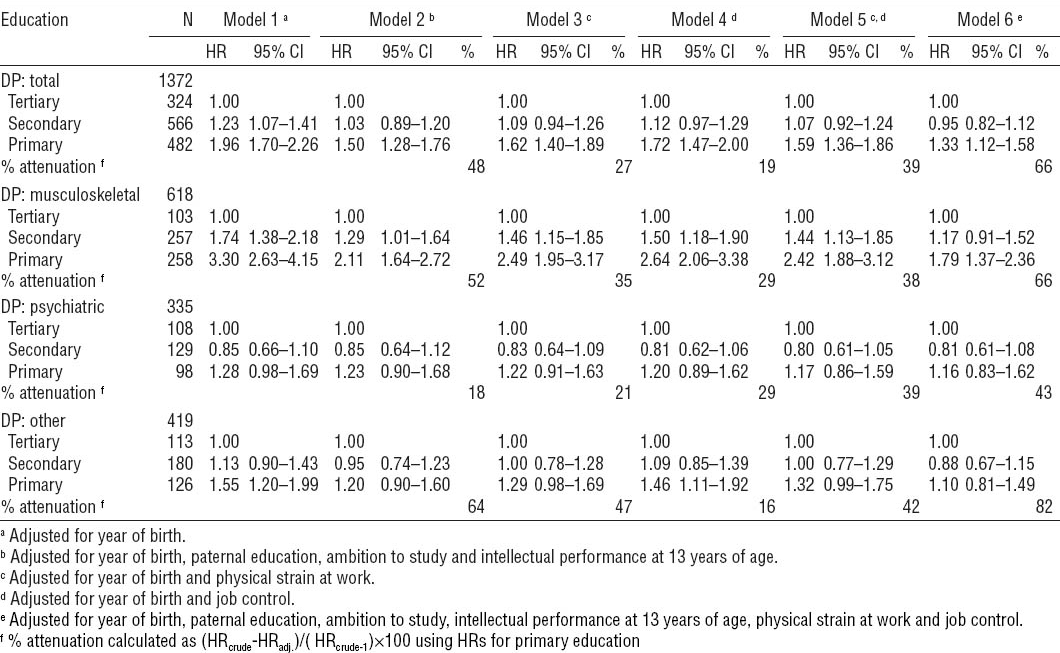
The strong attenuations from the early-life adjustment ought not to be due to collinearity. None of the coefficients measuring the correlations of paternal education, ambition to study, and intellectual performance at age 13 years with subsequent educational attainment were >0.40 (data not shown).
Discussion
Women were found to have considerably higher rates of disability pension than men, regardless of diagnosis, whereas men had a steeper increase in disability pension by declining educational level. Disability pension was rare in the high-educated men. Adjustment of associations for paternal education, ambition to study, and intellectual performance at age 13 had a considerable attenuating effect, also when disability pension with a musculoskeletal diagnosis was the outcome. In spite of this, high physical strain at work and low job control both appeared to explain parts of the associations between low education and disability pensions in multivariable models.
Comparison with previous studies
Previous studies have shown that differences in physical strain and psychosocial working conditions (particularly job control) have robust associations with disability pension (16–18). Several studies have suggested that strenuous and repetitive working conditions could be factors mediating the association between lower education and disability pension (4, 12–15). However, many of these studies have been based on cross-sectional measurement of explanatory variables, which makes causal interpretations difficult.
Other studies have suggested that low education and disability pension are correlated due to common determinants (19, 20). Intellectual ability, psychosocial functioning, and physical abilities manifested relatively early in life, emerging from genetic and social background factors, have been shown to have considerable explanatory power regarding the association (21–23). These characteristics are known to affect educational attainment and also to explain variation in health behaviors and health outcomes, partly independent of education (24, 25). Confounding of associations between educational level, occupation-related working conditions, and disability pension is consistent with findings in the present study. It is also consistent with findings in our previous study (12) showing that health behaviors and, in particular, lower intellectual performance (IQ) measured at about 18 years of age attenuated the associations between lower education, occupational exposures, and disability pension. Interestingly, having a psychiatric or a musculoskeletal diagnosis before age 20 – not measured in the present study – were not found to be important confounders in that study.
We found weak associations between educational attainment and disability pension with psychiatric or other non-musculoskeletal disorders, particularly among women. This resembles another recent Swedish study, which indicated an association between higher education and risk of disability pension with depression or anxiety diagnoses among female participants (21). The much stronger association among both men and women in the present study between low education and disability pensions with a musculoskeletal diagnosis is in agreement with previous studies (1, 7). Furthermore, the finding that women more often than men had jobs with low control corresponds with a previous Swedish study (33). Low job control was frequent regardless of education among the women in the present study.
Interpretation
The main mechanism through which low education might contribute to disability pension is likely to be the increased risk of poor health among persons with lower education (10, 11). A potentially important link between education and health is thus strenuous and repetitive working conditions, which could be causes of ill-health and also act as obstacles to work among persons with health problems. Possibly, poor working conditions of this kind are particularly consequential in the presence of musculoskeletal and some other somatic disorders, explaining our finding of working conditions having greater impact as mediators when disability pensions with non-psychiatric diagnoses were outcomes. Disability pensions due to psychiatric disorders might not be influenced to any great extent by those same working conditions, the ones that distinguish educational groups the most. Therefore, these disability pensions might be more evenly distributed between non-manual and manual workers. Higher educated non-manual workers do not often retire as a result of musculoskeletal disorders (1).
Capturing the parts explained by working conditions is complicated because of confounding factors, however. This is illustrated in figure 1 and was confirmed in our analyses, through measures of paternal education, ambition to study, and intellectual performance. Thus, higher rates of disability pension among low educated men and women evidently also reflect differences between individuals, present already in childhood and affecting access to education and better working conditions in adulthood (22, 34). Our analyses should not be seen as an attempt to separate the contributions from early life and working conditions exactly, however.
Methodological considerations
A major strength of the present study is the access to longitudinal information about 13-year-old individuals collected in compulsory school, register-based data on education and occupation collected at 32–37 years of age, and long-term follow-up data through the ages of 55 and 60 years (of those born in 1953 and in 1948, respectively) from national records of disability pension with diagnoses. Furthermore, the tests of intellectual performance (IQ tests) in this study have been validated several times, including prediction of IQ-test scores at military enlistment at age 18 considered to be of a high quality (28, 29). “Ambition to study”, on the other hand, was a rough measure, possibly capturing both parental expectations and own motivation or self-discipline. The latter has been argued to be of considerable importance to educational outcomes (24). Paternal education may also be imperfectly measured, since the study participants reported this information when they were 13 years.
There are limitations to the measurement of working conditions. Working conditions were classified according to JEM based on occupational title. Such an approach has been proposed as a more objective way to collect information than self-reports, which may be sensitive to individuals’ claims, expectations, and health (35). A disadvantage with using inferred information is that some of the true variations are eliminated, which may lead to underestimation of true associations. However, in the Swedish Stockholm Heart Epidemiology Program (SHEEP) study and the British Whitehall study, associations between job control inferred from job titles and coronary heart disease and self-reported job control and coronary heart disease were shown to be similar (36, 37). Furthermore, working conditions were measured only once in the present study, at 32 or 37 years of age (in 1985). One might argue that these conditions could have changed subsequently and be misclassified during the follow-up. However, sensitivity analyses in our previous study, using the same exposure matrices on a similarly aged male cohort, showed no evidence of this (12). Using one or two measurement points in that study (five years apart) produced similar results. Finally, although job control and physical strain at work represent the main differences in working conditions between high and low educated people, there may hypothetically be factors of importance that we did not capture, eg, effort–reward imbalance (38).
We limited our study to disability pensions with musculoskeletal, psychiatric, and “other” diagnoses, which are not homogeneous categories. However, these have been used in previous studies and were large enough to avoid imprecision and instability in our multivariable analyses stratified by gender. Further, psychological distress (depression/anxiety symptoms) have been shown to account for disability pensions with somatic diagnoses, and psychiatric diagnoses seem underutilized for disability pensions (39, 40). It is therefore possible that disability pension due to psychiatric disorders were underestimated and disability pension due to somatic disorders overestimated. It is difficult to tell, however, how such a bias may be linked to level of education.
In conclusion, our study showed that physical and psychosocial working conditions seem to explain part of the increased rate of disability pension among low educated men and women, even though this association does reflect considerable selection effects based on factors already present in childhood.


